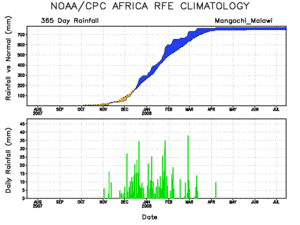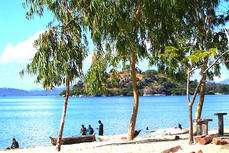Mangochi
| Mangochi | |
|---|---|
|
Lake Malawi, on eastern edge of Mangochi | |
 Mangochi Location in Malawi | |
| Coordinates: 14°27′36″S 35°16′12″E / 14.46000°S 35.27000°E | |
| Country |
|
| Region | Southern Region |
| District | Mangochi District |
| Population (2008)[1] | |
| • Total | 51,429 |
| • Languages | Yao |
| Time zone | +2 |
| Climate | Aw |
Mangochi is a township in the Southern Region of Malawi. Located near the southern end of Lake Malawi, in colonial times it used to be called Fort Johnston. As of 2008 it has a population of 51,429.
History
Mangochi was founded by colonial administrator Sir Harry Johnston in the 1890s as a British colonial defence post on the littoral plain of the Shire River's western shore.[2] After this, Fort Johnston – as the town was then known – was an important slave market and administrative centre.[3]
The British gunboat Gwendolen was built in Mangochi in 1897.[3] At 340 short tons (310 t), it was the largest ship to sail on Lake Malawi until being scrapped shortly after World War II.[3] The gunboat, operated by the Protectorate of Nyasaland, scored an early success in World War I when it defeated the German vessel Hermann von Wissmann in August 1914.[4]
Rioting in June 2003 injured three people.[5] From March to November 2007, roughly 480 children were "rescued" from child labour on tobacco farms in Mangochi.[6] In July 2008, elephants terrorised areas around Maldeco Fisheries in Mangochi and caused several deaths and damage to property, mainly crops.[7] The Ministry of Tourism, Wildlife and Culture proposed moving the elephants into several game reserves, although the proposal stalled when some residents said they wanted the elephants to remain.[7]
Geography

Mangochi is at an elevation of 1,541 feet (470 m), near the southern end of Lake Malawi, between the main lakeshore road and the Shire River[3] and 5 miles (8 km) south of its entrance into Lake Malombe.[2] The town is roughly 120 miles (190 km) northeast of Blantyre, Malawi's largest city.[5] It is situated 1.4 miles (2.3 km) away from Mponda, 2.2 miles (3.5 km) away from Chipalamawamba, 2 miles (3.2 km) away from Mbaluku Laini and 1.4 miles (2.3 km) away from Yangala.
Climate
Mangochi has a tropical savanna climate (Köppen: Aw).
| Climate data for Mangochi | |||||||||||||
|---|---|---|---|---|---|---|---|---|---|---|---|---|---|
| Month | Jan | Feb | Mar | Apr | May | Jun | Jul | Aug | Sep | Oct | Nov | Dec | Year |
| Average high °C (°F) | 30.1 (86.2) |
30.0 (86) |
30.2 (86.4) |
29.5 (85.1) |
28.1 (82.6) |
26.5 (79.7) |
26.3 (79.3) |
28.3 (82.9) |
31.4 (88.5) |
33.6 (92.5) |
33.2 (91.8) |
31.0 (87.8) |
29.9 (85.8) |
| Daily mean °C (°F) | 25.5 (77.9) |
25.4 (77.7) |
25.3 (77.5) |
24.3 (75.7) |
22.1 (71.8) |
20.3 (68.5) |
20.1 (68.2) |
21.8 (71.2) |
24.5 (76.1) |
26.9 (80.4) |
27.3 (81.1) |
26.1 (79) |
24.1 (75.4) |
| Average low °C (°F) | 21.6 (70.9) |
21.5 (70.7) |
21.1 (70) |
19.8 (67.6) |
16.7 (62.1) |
14.2 (57.6) |
14.3 (57.7) |
15.4 (59.7) |
17.8 (64) |
20.8 (69.4) |
22.0 (71.6) |
22.0 (71.6) |
18.9 (66) |
| Average precipitation mm (inches) | 194.2 (7.646) |
200.8 (7.906) |
144.0 (5.669) |
36.6 (1.441) |
5.7 (0.224) |
4.4 (0.173) |
3.9 (0.154) |
1.5 (0.059) |
3.0 (0.118) |
15.9 (0.626) |
64.2 (2.528) |
172.0 (6.772) |
846.2 (33.315) |
| Average precipitation days (≥ 0.3 mm) | 16 | 14 | 13 | 6 | 2 | 2 | 2 | 2 | 1 | 2 | 7 | 14 | 81 |
| Average relative humidity (%) | 78 | 78 | 76 | 73 | 60 | 66 | 62 | 57 | 50 | 50 | 59 | 72 | 65 |
| Mean monthly sunshine hours | 204.6 | 187.6 | 238.7 | 252.0 | 279.0 | 255.0 | 257.3 | 279.0 | 288.0 | 300.7 | 258.0 | 207.7 | 3,007.6 |
| Mean daily sunshine hours | 6.6 | 6.7 | 7.7 | 8.4 | 9.0 | 8.5 | 8.3 | 9.0 | 9.6 | 9.7 | 8.6 | 6.7 | 8.23 |
| Source: NOAA[8] | |||||||||||||
Demographics
Population development
| Year | Population[1] |
|---|---|
| 1987 | 14,758 |
| 1998 | 27,055 |
| 2008 | 51,429 |
Languages and ethnicities
Yao, specifically of the Mangochi dialect, is the main language spoken in this town.[9] A Swahili settlement was also established in Mangochi.[10] Mangochi is mainly inhabited by the Yao people.[2]
Economy
Mangochi was developed as an agricultural centre and has marine-engineering shops. Cash crops grown in the area include tobacco, cotton, and groundnuts.[2] Rice and maize are intensively grown along the lakeshore, and commercial fishing is also important.[2]
Facilities
Amenities
Amenities include several shops, supermarkets, a post office and banks.[3]
Bridges
Within Mangochi there is the Bakili Muluzi Bridge, which Lonely Planet described as "scenic".[3]
Museums
The Lake Malawi Museum houses ethnic, environmental, and historical exhibits.[3] They include the Hotchkiss gun[3] with which the British gunboat Guendolin defeated the German gunboat Hermann von Wissmann with a single shot in their brief naval engagement in August 1914. The museum has also a scale model of the Guendolin.[3] An even older exhibit is a marine steam engine that was built in 1898 and powered the Universities' Mission to Central Africa's SS Chauncy Maples until 1953.[11]
Religion
Mangochi is home to a large mosque[3] as well as a modern Catholic Cathedral.[12]
Clocks
Mangochi is home to a clock tower erected in honour of Queen Victoria, dating back to the early 20th century.[12]
Transport
Mangochi is located just off the M3 road.[12] All buses travelling from Monkey Bay to Blantyre stop in Mangochi.[3] Minibuses travel to Liwonde, Zomba, and Blantyre.[3] Matolas travel to Liwonde National Park and to the border town of Chiponde.[3]
Tourism
Mangochi is described by Lonely Planet as having a "vaguely Swahili feel", with "palm trees, Arab-looking people and coconuts for sale in the street."[3] There are several guesthouses and lodges for tourists in Mangochi.[3] Pranay B. Gupte suggested staying at the Nkopola Lodge, where one can swim, fish, and sail.[13]
References
- 1 2 "World Gazetteer: Malawi: largest cities and towns and statistics of their population". World Gazetteer. Retrieved 17 July 2008.
- 1 2 3 4 5 "Mangochi". Encyclopaedia Britannica. 2008. Retrieved 18 July 2008.
- 1 2 3 4 5 6 7 8 9 10 11 12 13 14 15 Murphy, Alan; Armstrong, Kate; Firestone, Matthew D.; Fitzpatrick, Mary (2007). Lonely Planet Southern Africa: Join the Safari. Lonely Planet. p. 205. ISBN 1-74059-745-1.
- ↑ The Story of the Rhodesias and Nyasaland A. J. Hanna Faber and Faber, 1960
- 1 2 "Soldiers Sent To Help Quell Riots in Malawi". The New York Times. 29 June 2003. Retrieved 17 July 2008.
- ↑ "Attitudes to Child Labour Changing". UN Integrated Regional Information Networks. AllAfrica. 19 November 2006. Retrieved 17 July 2008.
- 1 2 Msiska, Karen (7 July 2008). "Mangochi against removal of elephants". The Daily Times. Retrieved 18 July 2008.
- ↑ "Mangochi Climate Normals 1961–1990". National Oceanic and Atmospheric Administration. Retrieved 8 March 2015.
- ↑ Baldauf, Richard B.; Kaplan, Robert (2004). Language Planning and Policy in Africa: Botswana, Malawi, Mozambique and South Africa. pp. 85–89. ISBN 1-85359-725-2.
- ↑ Baldauf, p. 91
- ↑ "The Ship". Chauncy Maples, Lake Malawi's Clinic. Chauncy Maples Trust. 2009–2011. Retrieved 28 July 2011.
- 1 2 3 "Mangochi". Malawi Tourism. Retrieved 18 July 2008.
- ↑ Gupte, Pranay B. (28 September 2008). "Malawi Now Inviting Visitors to Its Feast of Beauty; Malawi Is Now Inviting Visitors to Share in Its Feast of Natural Beauty If You Go". The New York Times.
External links
Coordinates: 14°28′S 35°16′E / 14.467°S 35.267°E
